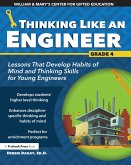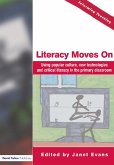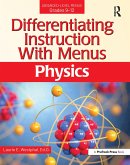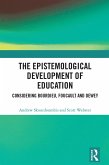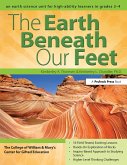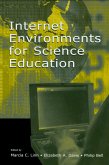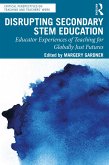Lenore Teevan
Thinking Like a Scientist (eBook, ePUB)
Lessons That Develop Habits of Mind and Thinking Skills for Young Scientists in Grade 5
31,95 €
31,95 €
inkl. MwSt.
Sofort per Download lieferbar

16 °P sammeln
31,95 €
Als Download kaufen

31,95 €
inkl. MwSt.
Sofort per Download lieferbar

16 °P sammeln
Jetzt verschenken
Alle Infos zum eBook verschenken
31,95 €
inkl. MwSt.
Sofort per Download lieferbar
Alle Infos zum eBook verschenken

16 °P sammeln
Lenore Teevan
Thinking Like a Scientist (eBook, ePUB)
Lessons That Develop Habits of Mind and Thinking Skills for Young Scientists in Grade 5
- Format: ePub
- Merkliste
- Auf die Merkliste
- Bewerten Bewerten
- Teilen
- Produkt teilen
- Produkterinnerung
- Produkterinnerung

Bitte loggen Sie sich zunächst in Ihr Kundenkonto ein oder registrieren Sie sich bei
bücher.de, um das eBook-Abo tolino select nutzen zu können.
Hier können Sie sich einloggen
Hier können Sie sich einloggen
Sie sind bereits eingeloggt. Klicken Sie auf 2. tolino select Abo, um fortzufahren.

Bitte loggen Sie sich zunächst in Ihr Kundenkonto ein oder registrieren Sie sich bei bücher.de, um das eBook-Abo tolino select nutzen zu können.
Thinking Like a Scientist focuses on high-interest, career-related topics in the elementary curriculum related to science
- Geräte: eReader
- ohne Kopierschutz
- eBook Hilfe
- Größe: 2.78MB
Andere Kunden interessierten sich auch für
![Thinking Like an Engineer (eBook, ePUB) Thinking Like an Engineer (eBook, ePUB)]() Debbie DaileyThinking Like an Engineer (eBook, ePUB)31,95 €
Debbie DaileyThinking Like an Engineer (eBook, ePUB)31,95 €![Literacy Moves On (eBook, ePUB) Literacy Moves On (eBook, ePUB)]() Literacy Moves On (eBook, ePUB)37,95 €
Literacy Moves On (eBook, ePUB)37,95 €![Differentiating Instruction With Menus (eBook, ePUB) Differentiating Instruction With Menus (eBook, ePUB)]() Laurie E. WestphalDifferentiating Instruction With Menus (eBook, ePUB)19,95 €
Laurie E. WestphalDifferentiating Instruction With Menus (eBook, ePUB)19,95 €![The Epistemological Development of Education (eBook, ePUB) The Epistemological Development of Education (eBook, ePUB)]() Andrew SkourdoumbisThe Epistemological Development of Education (eBook, ePUB)41,95 €
Andrew SkourdoumbisThe Epistemological Development of Education (eBook, ePUB)41,95 €![The Earth Beneath Our Feet (eBook, ePUB) The Earth Beneath Our Feet (eBook, ePUB)]() Clg Of William And Mary / Ctr Gift EdThe Earth Beneath Our Feet (eBook, ePUB)26,95 €
Clg Of William And Mary / Ctr Gift EdThe Earth Beneath Our Feet (eBook, ePUB)26,95 €![Internet Environments for Science Education (eBook, ePUB) Internet Environments for Science Education (eBook, ePUB)]() Internet Environments for Science Education (eBook, ePUB)57,95 €
Internet Environments for Science Education (eBook, ePUB)57,95 €![Disrupting Secondary STEM Education (eBook, ePUB) Disrupting Secondary STEM Education (eBook, ePUB)]() Disrupting Secondary STEM Education (eBook, ePUB)37,95 €
Disrupting Secondary STEM Education (eBook, ePUB)37,95 €-
-
-
Thinking Like a Scientist focuses on high-interest, career-related topics in the elementary curriculum related to science
Dieser Download kann aus rechtlichen Gründen nur mit Rechnungsadresse in A, B, BG, CY, CZ, D, DK, EW, E, FIN, F, GR, HR, H, IRL, I, LT, L, LR, M, NL, PL, P, R, S, SLO, SK ausgeliefert werden.
Produktdetails
- Produktdetails
- Verlag: Taylor & Francis
- Seitenzahl: 126
- Erscheinungstermin: 3. September 2021
- Englisch
- ISBN-13: 9781000489927
- Artikelnr.: 62526770
- Verlag: Taylor & Francis
- Seitenzahl: 126
- Erscheinungstermin: 3. September 2021
- Englisch
- ISBN-13: 9781000489927
- Artikelnr.: 62526770
- Herstellerkennzeichnung Die Herstellerinformationen sind derzeit nicht verfügbar.
The Center for Gifted Education at The College of William and Mary, a research and development center, was established in 1988 under the direction of Dr. Joyce VanTassel-Baska. The center provides services to educators, policy makers, graduate students, researchers, parents, and students in support of the needs of gifted and talented individuals. Located in Williamsburg, VA, the center has established a national reputation for excellence in research, curriculum development, and service. Several major grants, including funding from the Jacob K. Javits Gifted and Talented Students Education Act, have provided significant support for the work of the Center.
Introduction Preassessment Unit 1: What Do Scientists Do? Lesson 1.1: What
Does a Scientist Look Like? Lesson 1.2: What Is a Scientist? Lesson 1.3:
Project: Scientific Careers Unit 2: What Is the Scientific Method? Lesson
2.1: Observing Mystery Objects Lesson 2.2: Evaluating Hypotheses Lesson
2.3: Evaluating Data Lesson 2.4: Evaluating Types of Graphs and Charts
Lesson 2.5: Transformed "Floating Leaf Disk" Lab Unit 3: What Is the Role
of Evidence? Lesson 3.1: Analyzing Claims Lesson 3.2: Theories Are Like
Puzzles Lesson 3.3: Uncovering Misconceptions Unit 4: What Is Critical
Thinking? Lesson 4.1: Using the I2 Strategy Lesson 4.2: Deep Thinking Using
Claim, Evidence, and Reasoning Lesson 4.3: Project: Making Models of Earth
Motions Lesson 4.4: Project: Engineering a Boat Unit 5: Putting Scientific
Skills to Use Lesson 5.1: Project: Solar Oven Construction Lesson 5.2:
Project: Testing in Terrariums Lesson 5.3: Project: Working in Research
Teams Postassessment Answer Key References About the Author Next Generation
Science Standards Alignment
Does a Scientist Look Like? Lesson 1.2: What Is a Scientist? Lesson 1.3:
Project: Scientific Careers Unit 2: What Is the Scientific Method? Lesson
2.1: Observing Mystery Objects Lesson 2.2: Evaluating Hypotheses Lesson
2.3: Evaluating Data Lesson 2.4: Evaluating Types of Graphs and Charts
Lesson 2.5: Transformed "Floating Leaf Disk" Lab Unit 3: What Is the Role
of Evidence? Lesson 3.1: Analyzing Claims Lesson 3.2: Theories Are Like
Puzzles Lesson 3.3: Uncovering Misconceptions Unit 4: What Is Critical
Thinking? Lesson 4.1: Using the I2 Strategy Lesson 4.2: Deep Thinking Using
Claim, Evidence, and Reasoning Lesson 4.3: Project: Making Models of Earth
Motions Lesson 4.4: Project: Engineering a Boat Unit 5: Putting Scientific
Skills to Use Lesson 5.1: Project: Solar Oven Construction Lesson 5.2:
Project: Testing in Terrariums Lesson 5.3: Project: Working in Research
Teams Postassessment Answer Key References About the Author Next Generation
Science Standards Alignment
Introduction Preassessment Unit 1: What Do Scientists Do? Lesson 1.1: What
Does a Scientist Look Like? Lesson 1.2: What Is a Scientist? Lesson 1.3:
Project: Scientific Careers Unit 2: What Is the Scientific Method? Lesson
2.1: Observing Mystery Objects Lesson 2.2: Evaluating Hypotheses Lesson
2.3: Evaluating Data Lesson 2.4: Evaluating Types of Graphs and Charts
Lesson 2.5: Transformed "Floating Leaf Disk" Lab Unit 3: What Is the Role
of Evidence? Lesson 3.1: Analyzing Claims Lesson 3.2: Theories Are Like
Puzzles Lesson 3.3: Uncovering Misconceptions Unit 4: What Is Critical
Thinking? Lesson 4.1: Using the I2 Strategy Lesson 4.2: Deep Thinking Using
Claim, Evidence, and Reasoning Lesson 4.3: Project: Making Models of Earth
Motions Lesson 4.4: Project: Engineering a Boat Unit 5: Putting Scientific
Skills to Use Lesson 5.1: Project: Solar Oven Construction Lesson 5.2:
Project: Testing in Terrariums Lesson 5.3: Project: Working in Research
Teams Postassessment Answer Key References About the Author Next Generation
Science Standards Alignment
Does a Scientist Look Like? Lesson 1.2: What Is a Scientist? Lesson 1.3:
Project: Scientific Careers Unit 2: What Is the Scientific Method? Lesson
2.1: Observing Mystery Objects Lesson 2.2: Evaluating Hypotheses Lesson
2.3: Evaluating Data Lesson 2.4: Evaluating Types of Graphs and Charts
Lesson 2.5: Transformed "Floating Leaf Disk" Lab Unit 3: What Is the Role
of Evidence? Lesson 3.1: Analyzing Claims Lesson 3.2: Theories Are Like
Puzzles Lesson 3.3: Uncovering Misconceptions Unit 4: What Is Critical
Thinking? Lesson 4.1: Using the I2 Strategy Lesson 4.2: Deep Thinking Using
Claim, Evidence, and Reasoning Lesson 4.3: Project: Making Models of Earth
Motions Lesson 4.4: Project: Engineering a Boat Unit 5: Putting Scientific
Skills to Use Lesson 5.1: Project: Solar Oven Construction Lesson 5.2:
Project: Testing in Terrariums Lesson 5.3: Project: Working in Research
Teams Postassessment Answer Key References About the Author Next Generation
Science Standards Alignment

